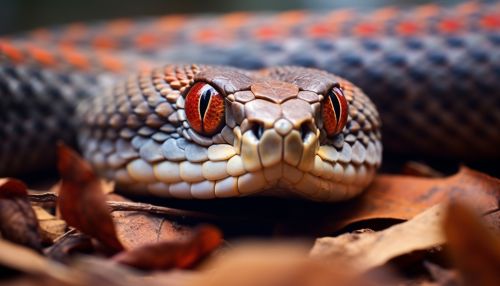Serpentes
Overview
Serpentes, commonly known as snakes, are a suborder of reptiles in the order Squamata. They are characterized by their elongated bodies and absence of limbs. There are over 3,600 known species of snakes, inhabiting a diverse range of habitats across the world.


Evolution
The evolution of snakes is a subject of ongoing scientific research. Fossil evidence suggests that snakes may have evolved from burrowing lizards during the mid-Cretaceous period, approximately 100 million years ago. The oldest known snake fossils, such as Eophis underwoodi, date back to this period.
Anatomy and Morphology
Snakes exhibit a unique anatomy that differentiates them from other reptiles. They lack limbs and external ears, and have elongated bodies and specialized skulls. Their internal organs are also elongated and arranged linearly to accommodate their slender body structure.
Skull and Jaw Structure
The skull of a snake is a complex structure, designed for the ingestion of large prey. Snakes have a highly kinetic skull, with numerous mobile joints that allow the mouth to open wide. The lower jaw, or mandible, is not fused at the front, enabling further expansion.
Scales
The skin of a snake is covered in scales, which provide protection and aid in locomotion. The scales, made of keratin, are periodically shed as the snake grows, in a process known as ecdysis.
Internal Organs
The internal organs of snakes are elongated and arranged linearly. The left lung is often reduced or absent, to accommodate the slender body shape. The heart is able to move within the body to avoid compression when large prey is swallowed.
Behavior
Snakes exhibit a range of behaviors, from solitary to social, and have various methods of locomotion, hunting, and reproduction.
Locomotion
Snakes use several methods of locomotion, including lateral undulation, sidewinding, concertina movement, and rectilinear movement. The method used depends on the species and the terrain.
Hunting and Feeding
Snakes are carnivorous, feeding on a variety of prey including rodents, birds, eggs, and other reptiles. Some snakes, such as the python, constrict their prey, while others, like the viper, use venom to immobilize and digest their food.
Reproduction
Most snakes are oviparous, laying eggs that are incubated externally. However, some species are ovoviviparous or viviparous, giving birth to live young.
Classification
Snakes are classified into 20 families, which include a diverse range of species. Some of the most well-known families include the Colubridae, Viperidae, and Elapidae.
Conservation
Many snake species are threatened by habitat loss, pollution, and hunting. Conservation efforts are ongoing to protect these species and their habitats.
